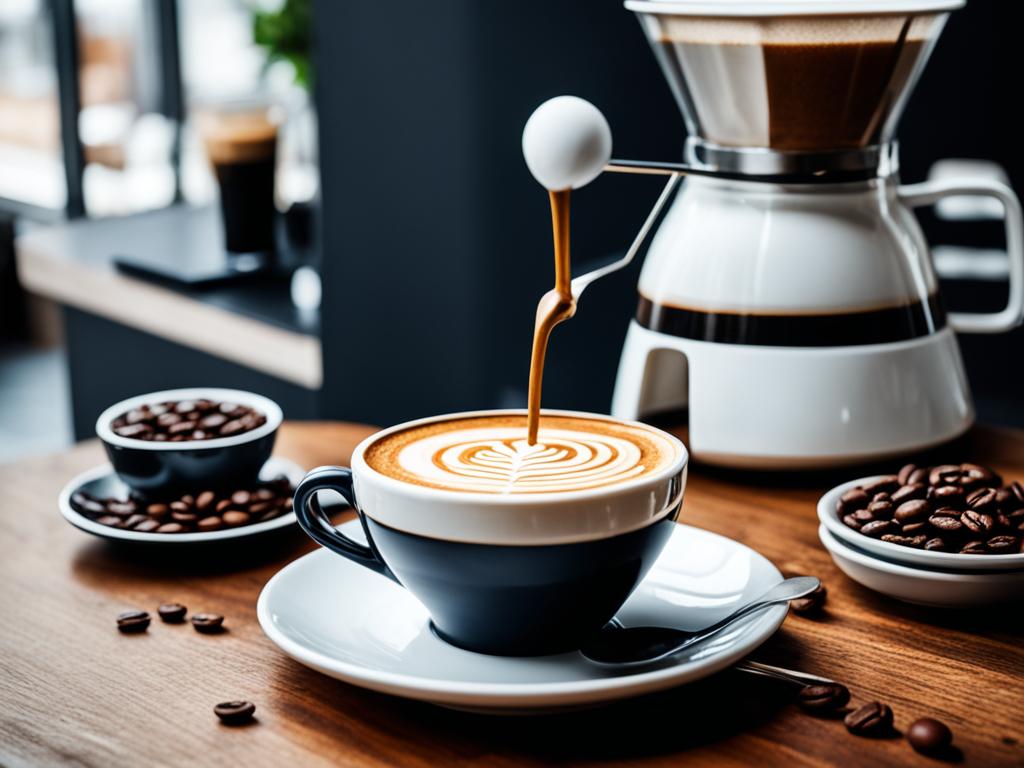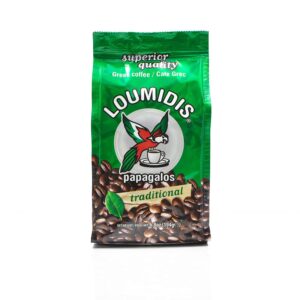“Coffee has two virtues: it is wet and warm.” – King Charles II
Greek coffee history is not just a narrative of a beverage but an exploration of deep-rooted traditions and cultural nuances that span centuries. Starting from the Ottoman Empire’s rule, Greek coffee has become an integral part of everyday life in Greece, shaping social interactions and private moments alike.
In the 17th century, Thessaloniki alone boasted over 300 coffee shops, making it an epicenter of Greek coffee culture. By the 18th century, the kafeneio became a well-established institution for social interaction in Greece. These traditional kafeneios, along with the specialized coffee grinding shops called “kafekopteia” that emerged in the late 19th and early 20th centuries, laid the foundation for the rich tapestry of Greek coffee traditions.
The introduction of the frappé in the 1960s revolutionized Greek coffee culture, swiftly becoming a national favorite. The arrival of the third wave of coffee in the early 2000s only deepened Greece’s appreciation for quality coffee. Despite economic hardships like the 2008 crisis, coffee sales in Greece rose, underscoring its significance to Greek coffee culture. Greeks liken drinking coffee to washing one’s face in the morning, a necessity that underscores the ritualistic importance of the beverage.
From the beloved “ibrik” coffee to the modern frappé and freddo, Greek coffee culture is vibrant and ever-evolving. The essence of filoxeneia, or “friend to a stranger,” remains a cornerstone of Greek hospitality and is vividly represented in the ubiquitous coffee shops that dot Greece. The historical and cultural significance of Greek coffee ensures it’s not just consumed, but savored and cherished.
Key Takeaways – Greek Coffee History
- Greek coffee history dates back to the Ottoman Empire, evolving through centuries.
- Kafeneios became central to Greek coffee culture by the 18th century.
- The frappé, introduced in the 1960s, became a national favorite in Greece.
- Despite economic challenges, Greek coffee culture thrives due to its deep-rooted significance.
- The concept of “filoxeneia” highlights the importance of hospitality in Greek coffee traditions.
The Origins of Greek Coffee
The rich origins of Greek coffee can be traced back to the Ottoman Empire. This section delves deep into how Greek coffee tradition evolved over centuries, shaped by historical, cultural, and social influences.
The Ottoman Influence
The Ottoman coffee culture played a substantial role in shaping the origins of Greek coffee. The first ‘kafeneio’ was established in Constantinople (now Istanbul) around 1475. This marked the beginning of coffee as a social and cultural staple in the region. During the Ottoman era, coffee became deeply integrated into daily life and social interactions, setting the stage for Greece’s unique coffee tradition.
First Coffee Shops in Greece
By the 17th century, the coffee landscape had evolved significantly in Greece. Thessaloniki alone boasted over 300 coffee shops, serving as vital social hubs that influenced Greek coffee culture profoundly. These early establishments, known as the first Kafeneio in Greece, were instrumental in popularizing coffee as a daily ritual. Greeks adopted the brewing techniques and later adapted them to resonate with their local tastes and preferences, setting the foundation for what we now recognize as the distinctive Greek coffee tradition.
| Aspect | Details |
|---|---|
| First Kafeneio Established | 1475 in Constantinople |
| Coffee Shops in Thessaloniki in 17th Century | Over 300 |
| Greek Coffee Preparations | 48 Different Methods |
| Coffee Consumption | 5.5 kg per person annually |
| Social Significance | Coffee with friends lasts 1.5 to 2 hours |
From the early influence of the Ottoman coffee culture to the establishment of the first Kafeneio in Greece, the Greek coffee tradition has evolved into a rich tapestry of social and cultural practices. The legacy continues as both the traditional and modern iterations of Greek coffee thrive, reflecting the deep-rooted love Greeks have for their coffee.
The Importance of Greek Coffee Culture
In Greece, coffee is far more than just a drink; it’s a daily ritual that is deeply ingrained in the culture. The phrase “pame gia kafe” is more than an invitation for coffee—it’s a call to socialize and connect with others in a leisurely setting. With Greece ranking among the top fifteen countries globally in per capita coffee consumption, averaging 5.5 kg of coffee consumed per person per year, it’s evident how central coffee is to daily life.
Coffee: A Daily Ritual
The concept of the Greek coffee daily ritual is akin to a necessity, much like washing one’s face in the morning. This ritual often spans one and a half to two hours when shared with friends, underscoring the social aspect of Greek coffee customs. Coffee in Greece isn’t just about the beverage itself; it’s a multifaceted experience. With 48 different preparations, Greek coffee showcases a wide variety of ways to be enjoyed, from the traditional ibrik coffee to the modern frappé and freddo, catering to the evolving preferences of a highly informed and demanding audience.
Filoxeneia: Greek Hospitality
One of the quintessential elements of Greek culture is Greek hospitality, known as “filoxeneia.” This term beautifully encapsulates the idea of being a “friend to a stranger” and underscores the pride Greeks take in their hospitality. This philosophy is deeply embedded in Greek coffee customs and extends to customer service in coffee shops. From the luxurious European-oriented cafes that began in the late 19th century to the contemporary barista-driven coffee scenes, the essence of filoxeneia in Greece ensures that every coffee encounter is marked by warmth and exceptional service.
| Aspect | Details |
|---|---|
| Average Coffee Consumption | 5.5 kg per person per year |
| Number of Coffee Preparations | 48 different types |
| Social Coffee Duration | 1.5 to 2 hours |
| Start of Luxurious Cafes | Late 19th century |
| Key Elements of Coffee Culture | Greek coffee daily ritual, Greek coffee customs, Greek hospitality, filoxeneia in Greece |
Traditional Greek Coffee and Its Significance
Traditional Greek coffee, also referred to as ibrik or simply Greek coffee, holds a deeply rooted place in Greek culture. This time-honored beverage is renowned for its rich, foamy texture, which is meticulously brewed using a brass or copper pot called a briki.
The cultural significance of Greek coffee extends beyond its delightful taste; it symbolizes a long-standing tradition intertwined with Greek daily life and social customs. Historically, Greek coffee was more than just a drink; it was a social ritual, particularly in the traditional cafés known as kafeneio, which were vital social hubs engaging primarily male audiences and serving as a cornerstone of community interaction.
The historical Greek coffee narrative reveals that it was the most popular beverage in Greece from the creation of the Greek state until the Second World War. Greek coffee practices have evolved over centuries, with 48 different preparations that highlight its unique characteristics and diverse variants. This tradition was further enriched by the modernization of coffee culture in the late 19th century, with the introduction of luxurious cafés and cafeterias that catered to a broader audience, including women and the upper economic classes.
Even today, Greece remains among the top fifteen countries in the world in per capita coffee consumption, with an impressive average of 5.5 kg per person per year. The enduring appeal of traditional Greek coffee is a testament to the intricate relationship between coffee and Greek societal norms, reflecting its deep-seated presence in both public spaces and private homes. This rich coffee tradition underscores how an ancient practice has continually adapted to contemporary tastes, ensuring its relevance in modern Greek life.
This historical backdrop, coupled with the present-day diversity of Greek coffee variants, encapsulates why Greek coffee is more than just a beverage—it is a cultural staple that captures the essence of Greek hospitality and the strong sense of community that defines the nation.
| Aspect | Details |
|---|---|
| Average Consumption | 5.5 kg per person per year |
| Historical Popularity | Most popular beverage until WWII |
| Preparation Variations | 48 different methods |
| Significant Locations | Kafeneio, Public and Private Spaces |
The Evolution of Greek Coffee Drinking
The evolution of coffee drinking in Greece exemplifies a fascinating blend of tradition and modernity. From the historical kafeneio to today’s third-wave coffee shops, the journey reflects the changing tastes and social dynamics of Greek society. Let’s explore this evolution, touching upon key aspects of the transformation.
The Rise of Kafeneio
The concept of the kafeneio has been a cornerstone in Kafeneio history, serving as social hubs since the creation of the Greek state. These traditional Greek cafés were more than just places to enjoy a cup of coffee; they fostered community interactions, political discussions, and cultural exchanges. By the 17th century, Thessaloniki alone boasted over 300 coffee shops, indicating the city’s rich coffee culture and the profound social significance of these establishments.


Modern Kafeterias
As Greece moved into the modern era, the traditional kafeneio evolved into kafeterias, adapting to the tastes of younger generations. These modern Greek coffee establishments offer a mix of traditional and international coffee drinks, appealing to contemporary lifestyles while preserving the essence of Greek coffee culture. The rise of modern Greek coffee venues reflects a society that values both its rich heritage and the innovations of the global coffee scene.
Third Wave Coffee in Greece
The 21st century saw the emergence of the third-wave coffee movement in Greece. This trend focuses on high-quality coffee, artisanal brewing methods, and a deeper appreciation for the coffee experience. Third-wave coffee in Greece gained momentum in the 2000s, with coffee lovers seeking diverse flavors and refined techniques. The trend showcases the Greek passion for evolving coffee tastes, while still honoring traditional roots. Espresso-based drinks like Freddo Espresso and Freddo Cappuccino became popular, representing a modern twist on the classic Greek coffee culture.
In conclusion, the evolution of coffee drinking in Greece underscores a unique journey from the historic kafeneio to the contemporary third-wave coffee shops. This transformation mirrors the dynamic interplay between maintaining traditions and embracing modern trends, illustrating the enduring and innovative spirit of Greek coffee culture.
| Era | Key Developments | Significance |
|---|---|---|
| 15th-17th Century | Rise of traditional kafeneio | Social hubs for community, politics, and culture |
| 20th Century | Introduction of frappé and modern kafeterias | Blending traditional and global influences |
| 21st Century | Third-wave coffee movement | High-quality, artisanal coffee experiences |
The Greek Coffee Ceremony
The Greek coffee ceremony embodies a rich tradition of patience and meticulous preparation, showcasing some of the most cherished coffee serving traditions. This ceremony isn’t just about the end result but also the process, reflecting the cultural significance of kaimaki, the creamy foam atop each cup of properly brewed Greek coffee.
Brewing Methods: Briki and Gazaki
Central to Greek coffee brewing are the briki and gazaki. The briki, a small pot with a wide base and narrow top, ensures consistent heat distribution and proper brewing. The gazaki provides the low flame essential for gently heating the coffee. Together, these tools create the thick, rich brew beloved by so many.
Serving Greek Coffee with Kaimaki
No Greek coffee ceremony is complete without kaimaki. The significance of kaimaki lies in its creamy texture, achieved through careful Greek coffee brewing techniques. This foam not only enhances the flavor but also reflects the barista’s skill. Each cup, served in an elegant demitasse, represents an authentic experience, embodying centuries of tradition.
Siga, Siga: Slow Enjoyment
The Greek coffee ceremony aligns with the philosophy of siga, siga (slowly, slowly). This approach highlights the importance of savoring each moment, creating a relaxed environment centered around enjoying coffee. Whether during personal reflection or spirited conversation, this slow enjoyment turns each coffee moment into a cherished ritual.
Greek Coffee Favorites: Ibrik, Frappé, and Freddo
Greece’s coffee culture is a delightful journey through time, blending traditional methods with modern innovations. From the timeless ibrik coffee tradition to the refreshing creations like the Greek frappé and the innovative freddo coffee, each cup serves as a testament to the enduring love Greeks have for their coffee.
Ibrik Coffee: A Traditional Delight
The ibrik coffee tradition dates back centuries and remains an integral part of Greek coffee culture. Known for its rich, foamy texture, ibrik coffee is prepared in a special pot called a ‘briki.’ This method, steeped in history, is celebrated for its slow brewing process and the rich, robust flavors it produces. Greeks have cherished this coffee for generations, and it continues to be a favorite in traditional coffee shops across the country.
Frappé: Greece’s Iconic Iced Coffee
The Greek frappé, an iconic iced coffee, was invented in 1957 during an International Trade Fair in Thessaloniki. Nestlé introduced this deliciously frothy, chilled coffee, which quickly captured the hearts of Greeks. Made from instant coffee, water, sugar, and ice cubes, the frappé became the go-to drink for hot summer days. Its popularity soared, making it a beloved staple in Greek cafes.
Freddo: The Modern Twist
Emerging in the early 2000s, the freddo coffee innovation presented a modern twist on traditional espresso drinks by offering a refreshing cold alternative. Whether it’s a Freddo Espresso or a Freddo Cappuccino, this innovation has become a vital part of contemporary Greek coffee culture. With its smooth texture and creamy top, the freddo is the perfect choice for a summer beverage, adding a new dimension to the repertoire of popular Greek coffee recipes.
The Social Role of Greek Coffee Shops
Greek coffee shops, known as kafeneia, are much more than places to grab a drink; they are the lifeblood of social interaction in Greek communities. With roots dating back to the 18th century, these establishments have stood the test of time, becoming well-established social hubs. Over 300 coffee shops thrived in Thessaloniki alone by the 18th century, underpinning the essence of Greek coffee shop culture.
Kafeneio as Social Hubs
At the heart of Greek coffee shop culture is the kafeneio, which serves as a focal point for daily interactions. The influence of a kafeneio’s social role is profound, promoting a sense of community and belonging. People gather here to engage in discussion, play games, or simply enjoy each other’s company, making kafeneio indispensable to the coffee in Greek community experience.
The Role in Community Gatherings
Kafeneia and modern kafeterias alike play a significant role in community gatherings, acting as meeting points for various societal segments. Whether it’s casual get-togethers or more formal assemblies, the presence of coffee in Greek community events is a common thread. This tradition holds strong even through difficult times, like the economic crisis of 2008, when coffee sales in Greece saw an increase despite financial hardships.
Coffee at Celebrations and Events
The importance of coffee at Greek celebrations cannot be overstated. From weddings to community festivals, coffee serves as a unifying beverage that brings people together. Drinks like the ibrik coffee, frappé, and the more contemporary freddo are staples at these events, reflecting the diverse tastes and long-standing traditions. The concept of ‘filoxeneia,’ meaning ‘friend to a stranger,’ is evident in these settings, reinforcing the deeply rooted cultural norms of Greek hospitality and the significance of serving coffee at Greek celebrations.
Greek Coffee Brewing Techniques
When it comes to mastering Greek coffee techniques, one can’t overlook the role of the briki. This small, traditional coffee pot, usually made of copper, is essential for brewing Greek coffee to perfection. It not only influences the unique flavor but also allows for the creation of the desired thick and creamy foam, known as kaimaki.
The Role of the Briki
The briki is more than just a pot; it’s a symbol of tradition and precision in Greek coffee brewing. Unlike the coarser grind used in Turkish coffee, Greek coffee utilizes a finer grind, which is crucial for achieving its characteristic smooth texture. The briki’s design allows for even heating, which is essential for developing the rich, bold flavors that Greek coffee is known for.
Creating the Perfect Foam
One of the standout features of Greek coffee is its thick layer of foam. Achieving this “kaimaki” is a delicate process that involves slow brewing over a gentle heat. The coffee must be allowed to simmer just long enough to develop a thick, creamy foam on the top without boiling over. This foam is a sign of a well-made cup and adds to the unique texture of Greek coffee.
Unfiltered Coffee Texture
The unfiltered coffee texture is another defining characteristic of Greek coffee. The finer grind ensures that most of the grounds settle at the bottom of the cup, leaving a bold, flavorful drink on top. This unfiltered approach is key to capturing the deep, robust flavors that are so cherished in Greek coffee. While it shares similarities with Turkish coffee, the finer grind and the focus on foam distinguish it as a unique experience.
FAQ
What are the origins of Greek coffee?
How does Greek coffee differ from other types of coffee?
What role does coffee play in Greek culture?
What is the significance of the Greek coffee ceremony?
What are the different types of Greek coffee drinks?
How has Greek coffee culture evolved over time?
What are some traditional Greek coffee brewing techniques?
How do Greek coffee shops contribute to social life?
What is the role of ‘briki’ in Greek coffee preparation?
How important is ‘kaimaki’ in Greek coffee?
Source Links
- https://perfectdailygrind.com/2020/08/greek-coffee-culture-a-story-of-tradition-and-renewal
- https://www.greekboston.com/cooking/coffee-culture
- https://www.coffees.gr/greek-coffee-culture/?sl=en
- https://www.athensinsiders.com/blog/history-and-evolution-of-greek-coffee-culture
- https://perfectdailygrind.com/2020/08/greek-coffee-culture-a-story-of-tradition-and-renewal/
- https://www.linkedin.com/pulse/savoring-tradition-journey-world-greek-coffee-pure-joy-coffee
- https://unfoldinggreece.com/coffee-in-greece
- https://www.enjoylivingabroad.com/my-blog/greek-coffee-freddos-frappes-fortunetelling
- https://medium.com/@joethecoffeefan/greek-coffee-vs-turkish-coffee-unveiling-key-differences-and-personal-insights-16daa815defe
- https://www.thespruceeats.com/what-is-greek-coffee-765337
- https://www.elenianna.com/the-ultimate-guide-to-greek-coffee
Celebrity Chefs on Cooking with Greek People
Greek TV Chef Anna-Maria Barouh,
Facebook: Anna-Maria Barouh,
Instagram: annamariabarouh
Celebrity Chef, Food Stylist, Recipe Developer Anna Maria Barouh is our guest on Cooking with Greek People. Anna-Maria is a regular on Greek Television and has a very popular food blog and is a magazine contributor. YouTube Episode: Cooking with Greek People YouTube Episode






Mastering Greek Coffee: From How to Make Greek Coffee at Home to Exploring Greek Coffee Varieties
Discover the art of Greek Coffee Sketos, the sweetness of Greek Coffee Vary Glykos, and the balance of Greek Coffee Metrios. Dive into the rich History of Greek Coffee and the cherished Greek Coffee Rituals. Visit the Famous Greek Coffee Shops and discover the Best Greek Coffee Roasters to complete your Greek coffee journey.
Author: Bob
With over 20 years in Bioinformatics and AI in Molecular Diagnostics, Bob Stavrou advises BiCos, focusing on authenticating OLIVE OIL DNA. He's also a passionate contributor to YouTube Cooking with Greek People and appeared on Greek TV show Savvatokiriako Me Ton Manesi, bridging science and culinary arts. Watch it on Alpha TV.





